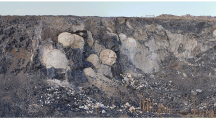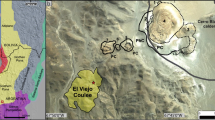Abstract
As shown by scanning and transmission electron microscopy, halloysite in three rhyolitic tephras occurs as squat and elongate ellipsoids. Both morphologies are presumed to result from a similar lattice building mechanism. The squat ellipsoids form from allophane; the elongate ellipsoids form from feldspars. The squat ellipsoids do not possess flattened faces or spaces between books of layers at field moisture levels. Outgrowths from the squat ellipsoids are possibly due to inclusions of allophane, glass, ferrihydrite, or feldspar crystallites. Possible spiral growth of halloysite, giving curved surfaces, may be due to a continuous distribution of crystal dislocations.
Резюме
С помощью сканирующего и трансмиционного электронного микроскопа было показано, что галлоизит в трех реолитовых тефрах встречается в виде сплющенных и вытянутых эллипсоидов. Обе морфологии предположительно являются результатом подобного механизма построения решетки. Сплющенные эллипсоиды формируются из аллофана, вытянутые эллипсоиды—из фельдшпата. В условиях полевого уровня влажности сплющенные эллипсоиды не имеют ни плоских поверхностей, ни расстояний между «книгами» слоев. Отростки сплющенных эллипсоидов вываны, возможно, инклюзиями аллофана, стекла, ферригидрита, или кристаллитов фельдшпата. Возможный спиральный рост галлоизита, который приводит к искривлению поверхности, может быть вызван сплошным распределением кристаллических дислокаций. [Е.С.]
Resümee
Raster- und transmissionselektronenmikroskopische Untersuchungen zeigten, daß Halloysit aus drei rhyolithischen vulkanischen Lockerprodukten als gedrungene oder längliche Ellipsoide auftritt. Es wird angenommen, daß beide Formen durch einen ähnlichen Gitterbildungsmechanismus entstehen. Die gedrungenen Ellipsoide bilden sich aus Allophan; die länglichen Ellipsoide entstehen aus Feldspäten. Die gedrungenen Ellipsoide haben bei Bergfeuchte keine glatten Flächen oder Zwischenräume zwischen Schichtpaketen. Auswüchse auf den gedrungenen Ellipsoiden sind wahrscheinlich durch Einschlüsse von Allophan, Glas, Ferrihydrit, oder Feldspatkristalliten bedingt. Ein mögliches Spiral—wachstum von Halloysit, das gebogene Oberflächen ergibt, könnte von einer kontinuierlichen Verteilung von Versetzungen im Kristall herrühren. [U.W.]
Résumé
La microscopie électronique balayante et à transmission montre que l’halloysite dans trois tephres est présente sous la forme d’ellipsoides trappus et élongés. On présume que les deux morphologies résultent d’un mécanisme semblable de construction de l’édifice cristallin. Les ellipsoides trappus sont formés à partir d’allophane, ceux qui sont élongés sont formés à partir de feldspars. Les ellipsoides trappus n’ont pas de faces aplaties ou d’espaces entre les livres de couches à des niveaux d’humidité naturels. Des protrusions des ellipsoides trappus sont possiblement dus à des inclusions d’allophane, de verre, de ferrihydrite, ou de cristallites de feldspars. La croissance en spirale possible d’halloysite, donnant des surfaces recourbées, peut être due à une distribution continuelle de dislocations de cristaux. [D.J.]
Similar content being viewed by others
References
Askenasy, P. E., Dixon, J. B., and McKee, T. R. (1973) Spheroidal halloysite in a Guatemalan soil: Soil Sci. Soc. Amer. Proc. 37, 799–803.
Bates, T. F. (1962) Halloysite and gibbsite formation in Hawaii: in Clays and Clay Minerals, Proc. 9th Nat. Conf., West Lafayette, Indiana, 1960, Ada Swineford, ed., Per-gamon Press, New York, 315–328.
Bates, T. F., Hildebrand, F. A., and Swineford, A. (1950) Morphology and structure of endellite and halloysite: Amer. Mineral. 35, 463–484.
Birrell, K. S., Fieldes, M., and Williamson, K. I. (1955) Unusual forms of halloysite: Amer. Mineral. 40, 122–124.
Kirkman, J. H. (1975) Clay mineralogy of some tephra beds of Rotorua area, North Island, New Zealand: Clay Miner. 10, 437–449.
Kirkman, J. H. (1977) Possible structure of halloysite disks and cylinders observed in some New Zealand rhyolitic teph-ras: Clay Miner. 12, 199–216.
Kirkman, J. H. (1980) Mineralogy of the Kauroa Ash Formation of south-west and west Waikato, North Island, New Zealand: N.Z. J. Geol. Geophys. 23, 113–120.
Kirkman, J. H. and Pullar, W. A. (1978) Halloysite in late Pleistocene rhyolitic tephra beds near Opotiki, Coastal Bay of Plenty, North Island, New Zealand: Aust. J. Soil Res. 16, 1–8.
Moore, H. and Muhlethaler, K. (1963) Fine structure in frozen etched yeast cells. J. Cell Biol. 17, 609–628.
Nabarro, F. R. N. (1967) Theory of crystal dislocations: in The International Series of Monographs on Physics, N. F. Mott, E. C. Bullard, and D. H. Wilkinson, eds., Oxford University Press, Oxford, 39–42.
Parham, W. E. (1969) Halloysite-rich tropical weathering products of Hong Kong: Proc. Int. Clay Conf., Tokyo, 1969, Vol. 1, L. Heller, ed., Israel Univ. Press, Jerusalem, 403–416.
Saigusa, M., Shoji, S., and Kato, T. (1978) Origin and nature of halloysite in Andosoils from Towada Tephra, Japan: Geoderma 20, 115–129.
Visconti, Y. S., Nicot, B. N. F., and De Andrade, G. (1956) Tubular morphology of some Brazilian kaolins: Amer. Mineral. 41, 67–75.
Wada, S., Aoki, K., and Wada, K. (1977) The interior structure of spherical halloysite particles: Clay Sci. 5, 113–121.
Wolff, R. G. (1967) Weathering of Woodstock granite near Baltimore, Maryland: Amer. J. Sci. 265, 106–117.
Author information
Authors and Affiliations
Rights and permissions
About this article
Cite this article
Kirkman, J.H. Morphology and Structure of Halloysite in New Zealand Tephras. Clays Clay Miner. 29, 1–9 (1981). https://doi.org/10.1346/CCMN.1981.0290101
Received:
Accepted:
Published:
Issue Date:
DOI: https://doi.org/10.1346/CCMN.1981.0290101




